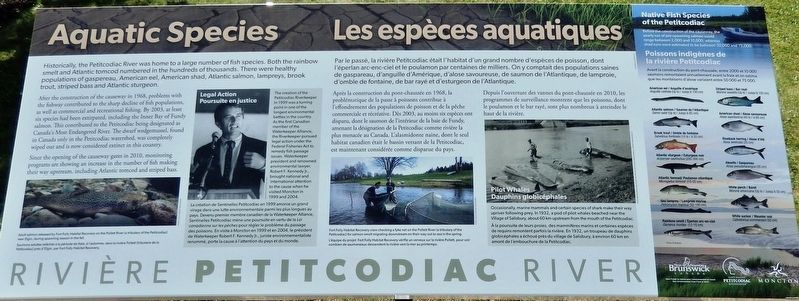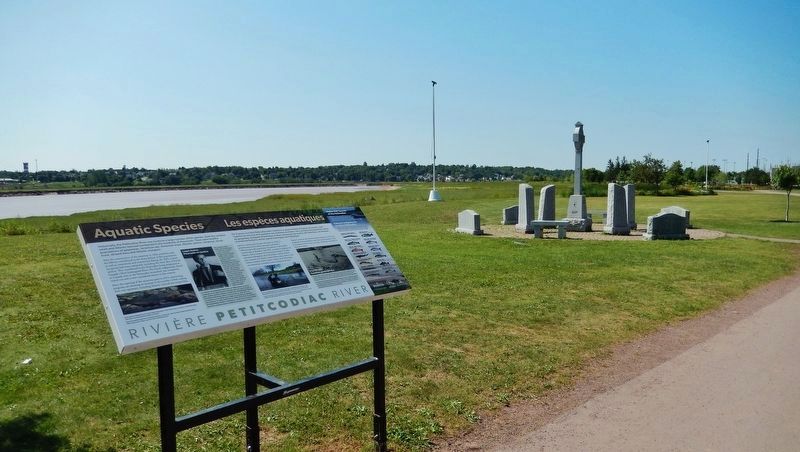Moncton in Westmorland County, New Brunswick — The Atlantic Provinces (North America)
Aquatic Species / Les espèces aquatiques
Riviére Petitcodiac River
Historically, the Petitcodiac River was home to a large number of fish species. Both the rainbow smelt and Atlantic tomcod numbered in the hundreds of thousands. There were healthy populations of gaspereau, American eel, American shad, Atlantic salmon, lampreys, brook trout, striped bass and Atlantic sturgeon.
After the construction of the causeway in 1968, problems with the fishway contributed to the sharp decline of fish populations, as well as commercial and recreational fishing. By 2003, at least six species had been extirpated, including the Inner Bay of Fundy salmon. This contributed to the Petitcodiac being designated as Canada's Most Endangered River. The dwarf wedgemussel, found in Canada only in the Petitcodiac watershed, was completely wiped out and is now considered extinct in this country.
Since the opening of the causeway gates in 2010, monitoring programs are showing an increase in the number of fish making their way upstream, including Atlantic tomcod and striped bass.
Par le passé, la rivière Petitcodiac était l'habitat d'un grand nombre d'espèces de poisson, dont l'éperlan arc-enc-ciel et le poulamon par centaines de milliers. On y comptait des populations saines de gaspareau, d'anguille d'Amérique, d'alose savoureuse, de saumon de l'Atlantique, de lamproie, d'omble de fontaine, de bar rayé et d'esturgeon de l'Atlantique.
Après la construction du pont-chaussée en 1968, la problématique de la passe à poissons contribue à l'effondrement des populations de poisson et de la pêche commerciale et récréative. Dès 2003, au moins six espèces ont disparu, dont le saumon de l'intérieur de la baie de Fundy, amenant la désignation de la Petitcodiac comme rivière la plus menacée au Canada. L'alasmidonte naine, dont le seul habitat canadien était le bassin versant de la Petitcodiac, est maintenant considérée comme disparue du pays.
Depuis l'ouverture des vannes du pont-chaussée en 2010, les programmes de surveillance montrent que les poissons, dont le poulamon et le bar rayé, sont plus nombreux à atteindre le haut de la rivière.
Topics. This historical marker is listed in these topic lists: Animals • Environment • Waterways & Vessels.
Location. 46° 5.204′ N, 64° 46.427′ W. Marker is in Moncton, New Brunswick, in Westmorland County. Marker can be reached from Assomption Boulevard, 0.2 kilometers east of Westmorland Street

Courtesy Fort Folly Habitat Recovery
2. Marker detail: Salmon release / Libération de saumon
• • •
Saumons adultes relâchés à la période de fraie, à l'automne, dans la rivière Pollett (tributaire de la Petitcodiac) près d'Elgin, par Fort Folly Habitat Recovery.
Other nearby markers. At least 8 other markers are within walking distance of this marker. The Shipbuilding Era / La construction navale (within shouting distance of this marker); Downing Place (about 120 meters away, measured in a direct line); Over the Years / Au fil des ans (about 120 meters away); An Economic Engine / Un moteur économique (about 150 meters away); From River to Firm Land / De la rivière à la terre ferme (about 150 meters away); The Art of Advertising / L’art de la publicité (about 210 meters away); Bilingual Banking / Une Banque Bilingue (about 240 meters away); Armenian Genocide Centennial Memorial (approx. 0.4 kilometers away). Touch for a list and map of all markers in Moncton.
Related markers. Click here for a list of markers that are related to this marker. Riviére Petitcodiac River
Also see . . . Petitcodiac River (Wikipedia). In 1968, a controversial rock-and-earth fill causeway was built between Moncton and Riverview to prevent agricultural flooding and to carry a crossing between the two communities. The causeway caused many problems for the river and its surrounding ecosystem. An estimated 10 million cubic metres of silt was deposited in the 4.7 km of

Courtesy www.petitcodiac.org
3. Marker detail: Legal Action / Poursuite en justice
• • •
La création de Sentinelles Petitcodiac en 1999 amorce un grand virage dans une lutte environnementale parmi les plus longues au pays. Devenu premier membre canadien de la Waterkeeper Alliance, Sentinelles Petitcodiac mène une poursuite en vertu de la Loi canadienne sur les pêches pour régler le problème du passage des poissons. En visite à Moncton en 1999 et en 2004, le président de Waterkeeper Robert F. Kennedy Jr., juriste environnementaliste renommé, porte la cause à l'attention du pays et du monde.
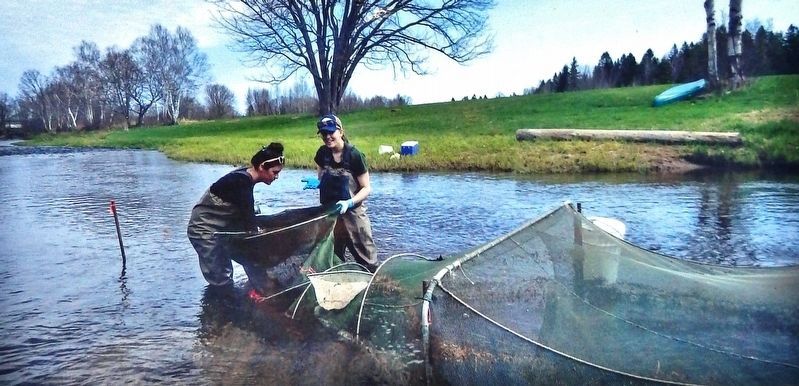
Courtesy Fort Folly Habitat Recovery
4. Marker detail: Fort Folly Habitat Recovery Crew
• • •
L'équipe du projet Fort Folly Habitat Recovery vérifie un verveux sur la rivière Pollett, pour voir combien de saumoneaux descendent la rivière vers la mer au printemps.
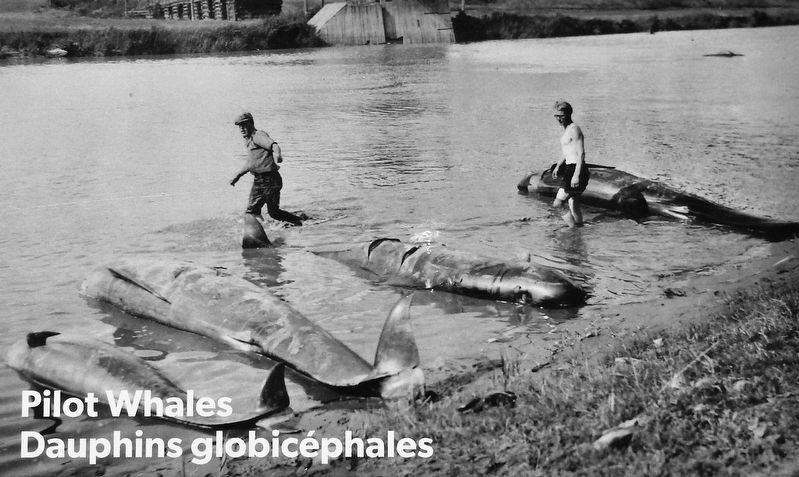
Courtesy New Brunswick Museum
5. Marker detail: Pilot Whales / Dauphins globicéphales
• • •
À la poursuite de leurs proies, des mammifères marins et certaines espèces de requins remontent parfois la rivière. En 1932, un troupeau de dauphins globicéphales a échoué près du village de Salisbury, à environ 60 km en amont de l'embouchure de la Petitcodiac.
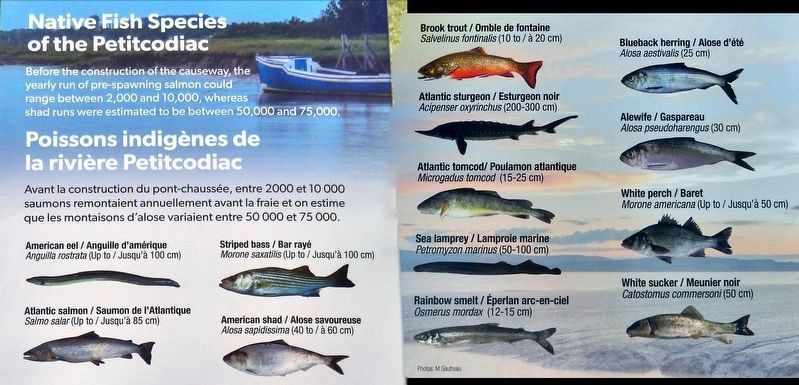
Photographed By (Photos) M.Gautreau
6. Sidebar: Native Fish of the Petitcodiac /
Poissons indigènes de la riviére Petitcodiac
Poissons indigènes de la riviére Petitcodiac
• • •
Avant la construction du pont-chaussée, entre 2000 et 10 000 saumons remontaient annuellement avant la fraie et on estime que les montaisons d'alose variaient entre 50 000 et 75 000.
• American eel / Anguille d'amérique
Anguilla rostrate (up to / Jusqu'à 100 cm)
• Striped bass / Bar rayé
Morone saxatilis (up to / Jusqu'à 100 cm)
• Atlantic salmon / Saumon de l'Atlantique
Salmo salar (up to / Jusqu'à 85 cm)
• American shad / Alose savoureuse
Alosa sapidissima (40 to / à 60 cm)
• Brook trout / Omble de fontaine
Salvelinus fontinalis (10 to / à 20 cm)
• Blueback herring / Alose d'été
Alosa aestivalis (25 cm)
• Atlantic sturgeon / Esturgeon noir
Acipenser oxyrinchus (200-300 cm)
• Alewife / Gaspareau
Alosa pseudoharengus (30 cm)
• Atlantic tomcod/ Poulamon atlantique
Microgadus tomcod (15-25 cm)
• White perch / Baret
Morone Americana (up to / Jusqu'à 50 cm)
• Sea lamprey / Lamproie marine
Petromyzon marinus (50-100 cm)
• Rainbow smelt / Éperlan arc-en-ciel
Osmerus mordax (12-15 cm)
• White sucker / Meunier noir
Catostomus commersoni (50 cm)
Credits. This page was last revised on June 25, 2022. It was originally submitted on June 7, 2020, by Cosmos Mariner of Cape Canaveral, Florida. This page has been viewed 142 times since then and 8 times this year. Photos: 1, 2, 3, 4, 5, 6, 7. submitted on June 7, 2020, by Cosmos Mariner of Cape Canaveral, Florida.
